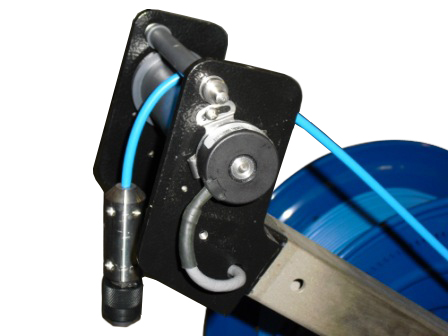R-Cam 1000 Winch
Overview
The coaxial cable is lightweight and Kevlar reinforced for strength. A shelf is located on the reel assembly to support the R-Cam Control Unit during operation.
An extendable boom arm on the reel assembly supports the camera over the well when lowering or raising the camera during the survey. An electronic encoder is mounted at the boom head and is used to display accurate footage information of the camera’s depth on the control unit video monitor. When the system is not in use the boom arm can be repositioned for easier storage, by simply removing the locking pin at the base of the boom arm, removing and rotating the arm 180 degrees, placing the arm back on the base and replacing the pin.
The winch is equipped with a 100 pulse per revolution, optical encoder to calculate the length of cable at any time.
What Customers Say
The camera is excellent and it makes a night and day difference in our business.
Gary Shawver
Shawver Well Company
I used to borrow a friendly competitor’s camera. He had a small one with a hand reel and a tripod made of PVC. It worked for me at times, but the R-cam 1000 is heads and shoulders above that.
Scott Miller
Northern Virginia Drilling
I hoped we would use our new R-CAM 1000 at least 1 time per month... but we're averaging closer to 10. Plus, I don't have to subcontract the work out to my competition anymore, and I'm picking up a bunch of additional well rehab work.
Al Boone
Boone Water Systems, Inc
Frequently Asked Questions
The downhole facing SC-166 is suitable for boreholes up to 10 inches in diameter. The R-CAM dual view camera can view boreholes up to 16 inches in diameter. The DC5150 is suitable for borehole diameters up to 30 inches in diameter. Please note, visibility downhole will be impacted by the clarity of the fluid and the available light.
Every camera system will eventually require a repair to the cable head, the point at which the cable and camera physically connect. Over time, the internal connections within the cable head can be strained to the point where they disconnect and cause interference or a complete loss of the video signal. To expedite the repair process, we have cable head repair kits available for both portable systems and large vehicle-based systems.
Conducting surveys with the included centralizers and available lens shield accessory is the best way to ensure that the camera head remains protected downhole. When not in use, store the camera head in an area where it will be safe from unintentional drops or damage. If your camera system is damaged, we offer full repair services at our headquarters in Fresno, California.









